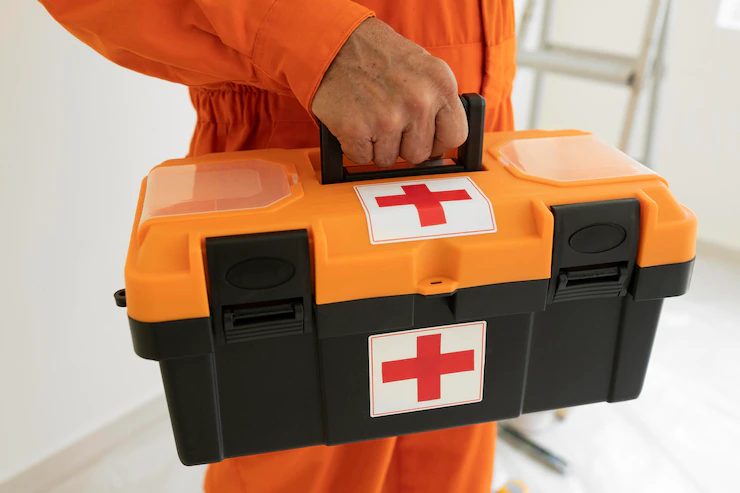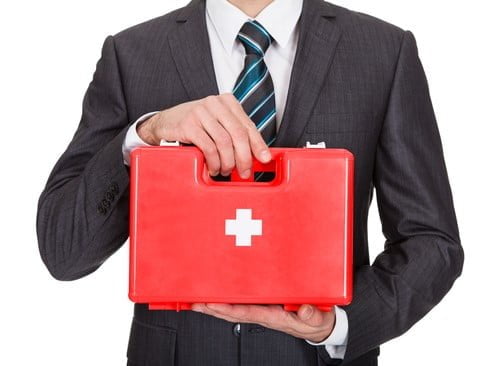Workplace Safety: 6 Company First Aid Kit Supplies

Table Of Contents
As a business owner, you need to invest in a lot of supplies for your employees to use during working hours. Depending on what industry you are in, you may need to purchase computers, office furniture, company vehicles, tools, and a wide range of other types of equipment and supplies.
One thing that is commonly overlooked, though, is a first aid kit. While OSHA (the Occupational Safety and Health Administration) does require business owners to keep first aid kits, not all businesses have them.
Owners often mistakenly think that accidents are not likely to occur in their place of business and thus overlook the importance of first aid kits.
In other cases, they have kits, but they fail to restock them when supplies are used. This can, of course, be problematic if someone gets hurt and the needed supplies are unavailable.
Workplace safety should be a primary concern for all business owners. If you are looking to make your place of business safer and ensure that it complies with OSHA regulations, keep reading to discover a few essential company first aid kit supplies.
OSHA-Mandated Supplies

The Occupational Safety and Health Administration mandates that all worksites (including offices and other small businesses) have an easily accessible, well-stocked first aid kit available to employees. When there are four or more employees, more than one kit may be required.
Under OSHA’s requirements, company first aid kits need to include gauze pads in various sizes, adhesive bandages, triangular bandages, gauze roller bandages, tweezers, scissors, adhesive tape, a blanket, latex gloves, two elastic wraps, a splint, resuscitation and instructions for requesting emergency assistance.
Keep in mind that these are just the minimum supplies that are required in order to be in compliance with OSHA regulations. There are plenty of other items that you should at least consider including in your kit.
1. Extra Clothing
There are a few instances in which extra clothing could come in handy during a workplace emergency. If the power goes out and your office is left without heat, for example, plain bulk hoodies could help keep your employees warm.
And if someone spills potentially dangerous chemicals or materials on themselves, having adult t-shirts on hand would give them something safe to change into. In a pinch, things like cotton t-shirts can also be used to absorb blood and apply pressure to wounds or create a makeshift tourniquet.
2. Water and Food
Having some water and food on hand for your employees is never a bad idea. Consider stocking up on a few cases of bottled water and some non-perishable snacks, such as beef jerky, granola bars, and trail mix. Having peanut butter and crackers on hand is a good idea, too.

In most emergency situations, your employees will leave work and go home. If they are ever stranded at the office, though, having food and water on hand could make a huge difference when it comes to ensuring everyone’s safety and well-being.
3. Over-the-Counter Medications
Over-the-counter medications like aspirin, antihistamines, and anti-diarrheal medicines are good to include in first aid kits. If you choose to include them in a first aid kit, however, make sure that all of your employees know that if they use them, they are doing so at their own risk.
4. Flashlights and Batteries
During emergencies, power outages are common. Having flashlights and batteries means that your employees will be able to see even if there are no lights to guide them. If you work in a building with multiple floors and would need to use stairways to evacuate, this is especially important. Flashlights will make navigating the stairs much easier and safer during a power outage.
5. Emergency Contact Information
Make sure that your employees know who to call in the event of an emergency by including a list of emergency contact information in your first aid kit. Include numbers for the local police and fire department along with phone numbers for contacting the Poison Control Center, your alarm company, and local hospitals.

It’s also wise to include contact information for your business’s gas, water, and electric companies. Include phone numbers for important members of your business, too, such as yourself, your managers, etc.
Take the time to train your employees to ensure that they know who to contact in the event of an emergency and how to get in touch with them. This simple step can go a long way toward mitigating the damage if something goes wrong.
6. Additional Considerations
Once you’ve put together a company first aid kit, make sure to store it in an area that is accessible to all employees and that everyone knows where it is. Consider requiring your workers to complete basic first aid training and CPR certifications to ensure that they will know exactly what to do in the event of an emergency. If you opt not to provide training, include a first aid manual in the kit.
Inspect your company’s first aid kit regularly. Replace any items that have been used. Check expiration dates on all products and replace them as needed. If you include food and water in your kit, replace it every six months or so.
Conclusion
As a business owner, OSHA requires you to have a first aid kit (or kits) for your employees. The items that are required are rather simple, but you can build a better kit by including some of the items listed above.
When working on your kit, consider any unique risks that your employees may face and be sure to include relevant items. You may also want to talk to your employees to get their input on what items they think should be in your company’s first aid kit.
Read Also:

























